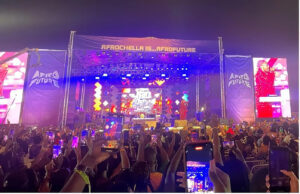Christmas is here again! For Ghanaians, it’s not just a festive season but a time when the world comes to Ghana to experience the country’s cultural diversity, hospitality, music and food. The GenZs will say “it’s a Detty December!”
With the elevation of the tourism value chain driven by the country’s Year of Return and Beyond the Return initiatives, visitors to Ghana in December have been constantly growing. 2021 international arrivals for December were 84,965 and that of 2022 was 105,214 – representing a percentage growth of 24 percent.

With an average length of stay of 14 nights, expenditure by tourists amounted to US$10.6million in 2022, according to the Ghana Tourism Report. For 2023, it is expected that over 100,000 visitors will come to the country during this year’s Detty December. According to the Ghana Tourism Authority (GTA) ‘December in Ghana’ endorsed events calendar, there will be nearly 100 different events during the period through to January 2024.
Traffic in the capital
With a population of over two million people, Accra will host a majority of the December events. The country’s capital city has a very complex traffic situation with significant congestion, especially during peak times and periods such as Christmas. The high population density, combined with the growth in the number of vehicles on the road, contributes to traffic challenges.
In an era of growing environmental concerns and with events taking centre-stage in Ghana, individuals and event organisers alike should find innovative ways to reduce waste and promote sustainability during this festive time of the year, especially on the side of transportation and vehicular movements.
When going to these events, patrons always want to drive their cars to the event venues even through the thick traffic around the event venues which causes vehicle emissions, particularly from the combustion of fossil fuels. This contributes to air pollution and the release of greenhouse gases such as carbon dioxide and nitrogen oxides. In fact, at this year’s COP28 in the United Arab Emirates, fossil fuel featured heavily in most conversations, with many suggesting how reliance on it can be minimised to protect the environment.
What is carbon footprint
A carbon footprint is the total amount of greenhouse gases, specifically carbon dioxide (CO2) and other carbon compounds, that are emitted directly or indirectly by an individual, organisation, event, product or process. It is usually measured in units of carbon dioxide equivalents (CO2e), which represent the impact of different greenhouse gases in terms of the amount of CO2 that would have the same global warming potential.

Vehicles contribute to carbon footprints primarily through the burning of fossil fuels, such as gasoline or diesel, for energy. The combustion of these fuels releases carbon dioxide and other pollutants into the atmosphere, contributing to climate change and air pollution. The carbon footprint of a vehicle encompasses not only the emissions from the fuel it burns but also the entire life cycle, including the manufacturing, transportation and disposal of the vehicle.
Simple things we can do
This feature explores practical ways of reducing carbon footprints associated with travel, emphasising sustainable transportation choices. By making conscious decisions, Ghanaians can enjoy the holiday season while contributing to a greener and more environmentally responsible celebration.
- Carpooling and ride-sharing: Instead of driving alone or going alone, why don’t you consider doing carpooling, where you and your friends can go in one vehicle to the event? If not driving but using ride-sharing services such as Yango, Uber or Bolt, it will be better to coordinate with your friends and come together and attend the event in one. Ride-hailing apps can create online platforms to facilitate coordination among people attending the same event.
- Using public transportation: I know this will be difficult…Hehehe! With the nature of public transport vehicles in Accra, imagine wearing a white dress and sitting in a public bus, also known as ‘troski’, to an event. It’s someway right! But do it for the public good. Event organisers can partner with transport owners to help facilitate this. The churches in Ghana have used this model and it has worked perfectly for their audience. Collaborate with local transportation authorities to optimise routes and schedules for these events.
- Community shuttles: Event organisers can also organise community shuttles for their events. Event organisers can divide Accra into zones – Tema, Adentan-Madina-Legon, Kaneshie, Dansoman, Lapaz, Kasoa, Teshie-Nungua-Labadi, and other communities to coordinate community bus shuttles to the events. Big events such as AfroFuture and Wildaland Festival can consider this strategy for their events. The last Wildaland Festival had buses from Accra Mall to Shai Hills, where the concert happened. This can reduce the number of individual vehicles on the road. Maybe collaborating with shuttle businesses to sponsor shuttle services can work.
- Park-and-ride facilities: It is also important for event organisers to get a spacious park that is near the event venue which is traffic-free so patrons can park their vehicles to reduce traffic congestion around the event venue area. A perfect scenario was adopted during the recently-held Tidal Rave at Labadi Beach Hotel. The organisers allocated the Trade Fair site for vehicle parking which helped reduce the traffic at the event venue.
We can lower our carbon footprint by adopting these sustainable mobility strategies into Christmas activities. December in Ghana offers an opportunity not just for joyful celebrations, but also for cultivating a dedication to environmentally friendly activities and a healthier and more sustainable future by working together.
>>>the writer is a communications executive with over a decade of professional experience in Public Relations, Media and Journalism. He is the Assistant Head of PR at Global Media Alliance and Lead Curator of the World Public Relations Day Festival. He is a passionate advocate of sustainability, climate change and creative arts.










